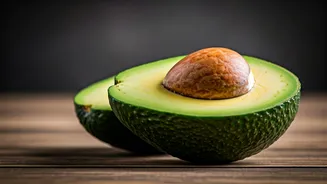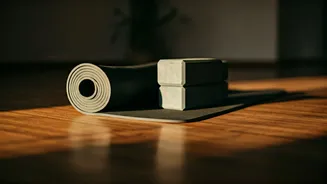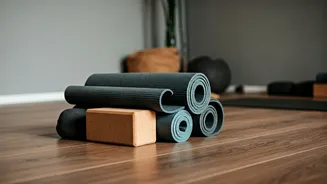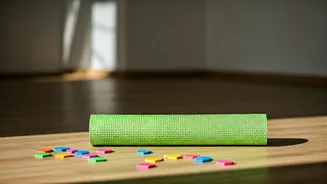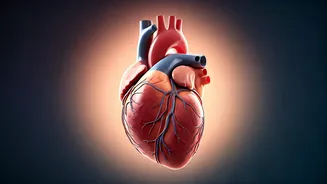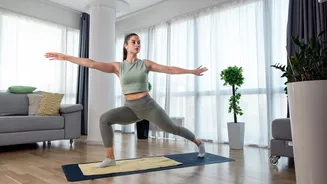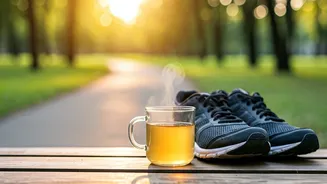Embracing the Practice
Neha Dhupia's decision to start her day with 108 Surya Namaskars, as she shared with her followers, is more than just a fitness regime; it's a holistic
approach to wellness. Surya Namaskar, which is also known as the sun salutation, is a sequence of 12 yoga postures that flow seamlessly together. This practice works the body and mind by promoting flexibility, strength, and mental clarity. It's often associated with improved cardiovascular health, reduced stress, and increased energy levels. It’s an effective exercise that can be practiced by individuals of different ages and physical conditions with slight modifications. The key lies in doing the asanas correctly and consistently, which can lead to significant improvements in overall health.
Pranamasana
The first step in the sequence is Pranamasana, or the prayer pose. In this asana, you stand tall with your feet together, ensuring a strong foundation, and your spine erect. Bring your hands together in front of your chest, mirroring the gesture of prayer or respect. This posture sets the intention for the practice. It is a moment of stillness and mindfulness, preparing your body and mind for the sequence. Pranamasana facilitates balance and concentration, and it creates a sense of gratitude and inner peace. By focusing on your breath, you can increase awareness and begin to quiet the mind before moving to the next asana. It is often regarded as a simple yet powerful asana as it harmonizes both the physical and mental states.
Hastauttanasana
Following Pranamasana is Hastauttanasana, or the raised arms pose. From the prayer position, inhale deeply and raise your arms overhead. Ensure your arms are straight and close to your ears, stretching your body upwards. Gently bend backward from your upper back while keeping your core engaged to prevent overextension in your lower back. This pose increases the stretch in the abdominal muscles, stretches the shoulders and chest muscles, improving circulation and flexibility. It is great for improving balance and can help in the removal of fatigue and tension. The pose helps energize the body by stimulating the nervous system. The stretch opens the chest, improving breathing and making you feel energized.
Hastapadasana
Next in the sequence is Hastapadasana, or the hand-to-foot pose. Exhaling, slowly bend forward from your hips, keeping your back straight. Try to touch your toes with your hands, keeping your knees straight, although some bending is permissible. If you can’t reach your toes, try bending your knees slightly to accommodate. In this pose, the core is activated, which helps with spinal alignment and improves digestion. This pose calms the brain and relieves stress and mild depression. It also enhances blood flow to the brain, which improves focus and concentration. By stretching the hamstrings and spine, it increases flexibility and improves the overall posture of the body.
Ashwa Sanchalanasana
After the forward bend, Ashwa Sanchalanasana, or the equestrian pose, comes next. Bring your left leg back and place your knee on the floor. Your right knee should remain bent, and your right foot should be between your hands. Look up, opening your chest. This pose is a great hip opener and also stimulates the digestive organs. Ashwa Sanchalanasana works on the muscles of the legs, especially the thighs, calves, and hip flexors, enhancing their strength and flexibility. It also helps in improving blood circulation to the abdominal organs. Practicing this pose with conscious breathing and a focused gaze is beneficial for balance and coordination, providing the body with stability.
Dandasana & Ashtanga Namaskar
Next, the sequence includes Dandasana (plank pose) and Ashtanga Namaskar (salute with eight points). In Dandasana, the whole body is positioned straight, like a plank, with the body weight supported by hands and feet. In the Ashtanga Namaskar, gently bring your knees, chest, and chin to the floor while your hands remain in the same position. The rest of the body is slightly raised. Ashtanga Namaskar strengthens the arms, chest, and legs, while stretching the spine and abdominal muscles. This pose helps improve blood circulation and also promotes lymphatic drainage. It fosters a sense of surrender and humility, connecting you to the earth. Both the poses complement each other and work on different muscle groups, thus contributing to an effective full-body workout.
Bhujangasana
Following Ashtanga Namaskar, Bhujangasana, or the cobra pose, is assumed. Slide your body forward, raising your chest while keeping your hands firmly on the ground, creating a gentle arch in the back. Your shoulders should be relaxed, and your gaze should be directed upward. Bhujangasana is excellent for the spine, increasing its flexibility and strength. It improves blood circulation and stimulates the abdominal organs, promoting better digestion. The asana gently stretches the chest and lungs, promoting deep breathing and increasing the body's energy levels. It also helps to relieve stress and fatigue and is excellent for those looking to improve their overall posture and spinal health.
Adho Mukha Svanasana
Then, come into Adho Mukha Svanasana, or the downward-facing dog pose. Lift your hips and form an inverted V-shape with your body, keeping your hands and feet on the ground. Your head should be relaxed, and your gaze should be directed towards your feet. This is an invigorating asana that stretches and strengthens the entire body. It improves blood circulation, particularly to the brain, which enhances concentration and reduces stress. Adho Mukha Svanasana stretches the hamstrings, shoulders, and calves, which helps in increasing flexibility. It is an excellent asana to increase the body’s energy levels and bring a sense of calm to the mind. This pose enhances blood flow, leading to rejuvenation and reducing fatigue.
Reversing the Sequence
From the downward-facing dog, reverse the steps to return to Pranamasana. Bring the right leg forward between the hands, mirroring Ashwa Sanchalanasana from the other side. Then, perform Hastapadasana and Hastauttanasana. The sequence concludes with Pranamasana. Breathing plays a crucial role throughout the Surya Namaskar practice. Inhale during poses that involve stretching and opening the body, and exhale when bending forward or contracting the body. Synchronizing breath with the movements adds to the practice’s effectiveness. Practicing 108 rounds provides a comprehensive physical workout. With consistent practice, you'll experience a sense of physical and mental well-being.


